DISA: Difference between revisions
(Started page, more context to be added later.) |
ArxCyberwolf (talk | contribs) (Added images.) |
||
| (10 intermediate revisions by 5 users not shown) | |||
| Line 1: | Line 1: | ||
{{Infobox manufacturer|hq=Højager 8, 2630 Taastrup, Denmark|founder=|key_people=|products=Metal casting products|names=Compagnie Madsen A/S (1900-1936) | |||
Dansk Rekyl Riffel Syndikat A/S (1936-2005) | |||
DISA Industries (2005-present)|image=Disa.png|founded=1900|title=DISA Industries A/S}}'''Dansk Industri Syndikat''', commonly shortened to '''DISA''', is a Danish manufacturer of metal casting products. During World War II, they were contracted by the Danish government to produce air raid sirens to warn the public of German air raids. Numerous sirens were produced by DISA during the war, including hand crank and gas-powered sirens. However, info on much of these has been lost to time or is very hard to come by, and as a result only 3 sirens are known to have been produced by them. | |||
== History == | |||
DISA was founded in 1900 as the '''Compagnie Masden''', producing Vilhelm Hermann Oluf Madsen's air-cooled, recoil-repeating machine gun, also named the Masden. Just before and during the occupation of Denmark by Germany, the Danish government commissioned DISA to produce and install air raid sirens across the country, and its factory in Copenhagen was used to make weapons. The production of these sirens would cease after the war, as there was no real purpose for them anymore. From there, DISA would go on to produce DISAMATIC forming machines and other foundry equipment to this day. | |||
== Products == | |||
=== E37 === | |||
[[File:E37.jpg|left|thumb|160x160px|An E37 as illustrated in a DISA advertisement.]] | |||
[[File:E37mount.png|thumb|160x160px|An illustration of an E37 and its roof mounting configurations.]] | |||
[[File:Model1977.jpg|left|thumb|254x254px|A Model 1977 cabinet.]] | |||
[[File:KT7DU.png|thumb|160x160px|Type 7DU (left) and Type KT67 (right) cabinets.]] | |||
The '''E37''', intended for use as an air raid siren, was developed by the newly established Civil Defense Agency (Danish: ''Civilforsvarsstyrelsen'') in the late 1930s and manufactured by DISA as a part of a nationwide air raid siren system. Its primary goal was to be as simple and mass producible as possible for rapid deployment across the country. Regulated by the Council, the E37 consists of an 8-port rotor and stator, with no grille or protection of any sort to prevent debris or foreign objects from entering the siren. A flange below the stator directs the siren's sound downwards and outwards. Arguably the siren's most notable feature would be the large protective roof installed above the stator; this roof both shielded the siren from the elements and propagated the siren's output downwards, filling in for the role a standard 2-peice shroud, commonplace at the time, would have served for cheaper. This is a design that was later incorporated into Elektror's L141, L52, and the widely successful E57, of which the E37 could be considered a predecessor of in a way, despite the 2 having no known connection apart from a similar appearance. The design of the protective roof and flange are inconsistent between E37 units but largely retain the same shape. | |||
A 220/230/380/400 V 5 kW (6.7 hp) 3 ph electric motor is located underneath the stator and drives the rotor at around 2800 rpm. The motor sits upon a large flanged circular base, of which the siren can be bolted down with. The E37 was primarily intended for roof mounting (although pole mounting was not nonexistent in Denmark), with a large wooden construction or a simple mast accompanying the siren when installed on top of a building. Despite the Council's original plans, DISA was the only company that distributed the E37, out of the many that were originally selected to; this decision was made hastily due to the rising geopolitical tensions in Europe at the time, and the increasing need for sirens to warn of potential air attacks from the Germans. The siren would be used in tandem with mobile electromechanical/electronic sirens and church bells, which were predominantly used in sparsely populated areas. 50 E37 sirens were ordered in 1938 and were installed in cities in Denmark that were subject to civil defense. Each order consisted of the DISA-made siren control cabinet Type KT (if one was not already present at another location), siren initiator cabinet Type 7DU, and the siren itself. The control cabinets were capable of radio activation and were offered in variants that could operate 2, 4, 6, 12 and 18 sirens at once; the control cabinet was also designed in a way where if desired, each siren could be controlled individually. | |||
The siren control and initiator cabinets themselves were located in signal rooms at municipal command centers, where the operator activated the sirens immediately after receiving warning orders received on special radio receivers. Activating sirens individually was useful in a variety of peacetime situations, such as activating 1 siren in a particular district where a fire has broken out. By the end of 1945, the number of E37 sirens installed had ballooned to over 500<ref name=":0">[https://jyskkoldkrigsforening.dk/varslingstjenesten Varslingstjenesten]</ref>; unfortunately, many of these locations were removed and dismantled following the war. DISA continued to sell the E37 during the Cold War, although companies such as Siemens, Carl Th. Malling, Kockum Sonics, LM Ericsson, and many others were formidable competition to DISA. In 1977, DISA introduced a new model of control cabinet under command of the Civil Defense Agency, fittingly named the Siren Command Cabinet and Siren Initiator Cabinet Model 1977 (Danish: ''Sirenekommandoskab og Sireneigangsætterskab Model 1977''). The Model 1977 was equipped with had the advantage of being able to activate 1 of a total of 5 different signals via the buttons on the front face of the cabinet, and a cancel button to prevent the wrong signal from being activated. The older control and initiator cabinets would not be wholly phased out until 1981. The cabinets were the only change made to the civil defense siren system; the old sirens remained in place. | |||
Beginning in 1992 and officially taking effect on midnight, 1 January 1993, the Civil Defense Agency and the Danish Fire Inspectorate (Danish: Statens Brandinspektion) were merged and reformed into the Danish Emergency Management Agency (Danish: ''Beredskabsstyrelsen''), soon after the Cold War came to a close. As such, the E37, along with the other siren offerings, were eliminated from DISA's lineup. Many of these sirens were removed following the implementation of the new nationwide siren system, which was planned, designed, and installed by the Danish Emergency Management Agency, [[Whelen Engineering]], and Denmark-based HSS Engineering. A dwindling number of E37 sirens remain, and even less of these are active to begin with; the units that survive today have remained for nearly a century and stand as reminders of the past. | |||
[[File:DISA E37D.png|left|thumb|160x160px|A privately owned DISA E37D.]] | |||
[[File:Good grief he's naked.png|thumb|160x160px|A DISA E37D with the screen removed.]] | |||
==== E37D ==== | |||
The '''E37D''' is another omnidirectional siren produced by DISA, being relatively similar to the E37, with the exception of a large mesh screen surrounding the siren's stator. Aside from this, the siren is relatively identical to the E37. The siren is able to be heard from up to 0.8 kilometers (0.4 miles) and weighs 140 kilos. Similarly, around 500 units were produced.<ref name=":0" /> It can be assumed they were discontinued when World War II ended in 1945. Several units still exist today, with one being located at the Zeppelin Museum in Denmark. | |||
==== LS 8 ==== | |||
The LS 8 is another siren produced by DISA. Due to a lack of information, little to nothing is known about this siren. Little to none of these are known to exist. The LS 8 was mentioned in a manual for the BD 8<ref>[http://www.jyskkoldkrigsforening.dk/wp-content/uploads/2014/02/Reservesirener.pdf BD 8 manual]</ref>, but aside from this, nothing else is known about them. It can be assumed they were discontinued when World War II ended in 1945. | |||
==== LS 8D ==== | |||
The LS 8D is presumably a variant of the LS 8. Like its counterpart, little to nothing is known about it. Only 71 LS 8Ds were made.<ref>https://www.youtube.com/@swiftybruh</ref> It can be assumed they were discontinued when World War II ended in 1945. | |||
=== Gas Powered Sirens === | |||
[[File:DISA BD 8.png|left|thumb|161x161px|A DISA BD 8 gasoline siren.]] | |||
==== BD 8 ==== | |||
The BD 8 is a gas-powered mobile siren produced by DISA and is arguably their most well-known. The main purpose of the BD 8 was to alert the Danish population in the event that stationary sirens were not able to function for whatever reason. Interestingly, mobile gas-powered sirens like the BD 8 had to be transported on the bed of a pick-up truck or small cargo truck, as it was illegal to transport them via moped or motorcycle.<ref name=":0" /> The BD 8 makes use of a single-cylinder two-stroke type MK.25C Villiers petrol engine directly coupled to the rotor. It has an 8 port chopper and stator that can have the pitch and sounds output controlled by the throttle as well as a manually controlled shutter to close off the ports. A "special ignition key" is required to start the motor. | |||
A pulley for starting the engine is attached to the crankshaft, provided with a notch for a pawl, so that the piston, when the engine is not in operation, can be moved to cover the siren's ports with a code ring, located around the siren's stator. The siren's fuel tank can hold a volume of 2.51 liters. The entire unit is attached to a two-wheeled cart which allows the siren to be transported to multiple locations. It can be assumed they were discontinued when World War II ended in 1945. Today, a handful of units exist, with a few going to museums and at least 2 being privately owned. | |||
=== Hand Operated Sirens === | |||
[[File:DISA hand crank.jpg|left|thumb|213x213px|A DISA hand-cranked siren.]] | |||
==== Hand operated siren ==== | |||
One particular model of hand operated siren is known to have been produced by DISA during the time they manufactured air raid sirens during World War II. Due to a lack of information regarding this siren, its model name is unknown. The siren utilizes a small, what looks to be 6 or 8 port rotor, which is driven by a hand crank with a wooden handle at the back of the siren. On the top of the stator, there is a small handle that allows for the siren to be carried. The siren is held up by a small 3-legged metal stand. There is a mesh screen surrounding the ports of the stator, as the siren is small enough to be handheld and could potentially cause injury if misused. There is also a grille on the front of the stator because of this. | |||
Below the base of the hand crank on the back of the siren, there is a small DISA logo and a tag that reads "Dansk Industri Syndikat", as well as smaller text below reading "Taastrup". These hand crank sirens were produced from 1935 to 1942. 500 of them were made, but only 1 is known to exist as of today. | |||
== References == | |||
[[Category:Engine-Driven]] | |||
[[Category:Electromechanical Sirens]] | |||
[[Category:Omnidirectional Sirens]] | |||
__INDEX__ | |||
[[Category:Mobile Sirens]] | |||
[[Category:Hand Powered]] | |||
[[Category:European Sirens]] | |||
[[Category:Company pages]] | |||
Latest revision as of 22:58, 16 October 2024
Dansk Industri Syndikat, commonly shortened to DISA, is a Danish manufacturer of metal casting products. During World War II, they were contracted by the Danish government to produce air raid sirens to warn the public of German air raids. Numerous sirens were produced by DISA during the war, including hand crank and gas-powered sirens. However, info on much of these has been lost to time or is very hard to come by, and as a result only 3 sirens are known to have been produced by them.
History
DISA was founded in 1900 as the Compagnie Masden, producing Vilhelm Hermann Oluf Madsen's air-cooled, recoil-repeating machine gun, also named the Masden. Just before and during the occupation of Denmark by Germany, the Danish government commissioned DISA to produce and install air raid sirens across the country, and its factory in Copenhagen was used to make weapons. The production of these sirens would cease after the war, as there was no real purpose for them anymore. From there, DISA would go on to produce DISAMATIC forming machines and other foundry equipment to this day.
Products
E37
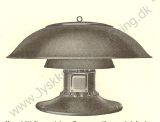
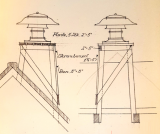
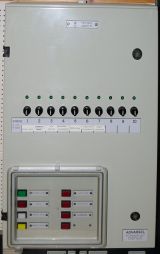
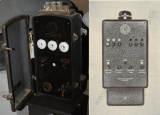
The E37, intended for use as an air raid siren, was developed by the newly established Civil Defense Agency (Danish: Civilforsvarsstyrelsen) in the late 1930s and manufactured by DISA as a part of a nationwide air raid siren system. Its primary goal was to be as simple and mass producible as possible for rapid deployment across the country. Regulated by the Council, the E37 consists of an 8-port rotor and stator, with no grille or protection of any sort to prevent debris or foreign objects from entering the siren. A flange below the stator directs the siren's sound downwards and outwards. Arguably the siren's most notable feature would be the large protective roof installed above the stator; this roof both shielded the siren from the elements and propagated the siren's output downwards, filling in for the role a standard 2-peice shroud, commonplace at the time, would have served for cheaper. This is a design that was later incorporated into Elektror's L141, L52, and the widely successful E57, of which the E37 could be considered a predecessor of in a way, despite the 2 having no known connection apart from a similar appearance. The design of the protective roof and flange are inconsistent between E37 units but largely retain the same shape.
A 220/230/380/400 V 5 kW (6.7 hp) 3 ph electric motor is located underneath the stator and drives the rotor at around 2800 rpm. The motor sits upon a large flanged circular base, of which the siren can be bolted down with. The E37 was primarily intended for roof mounting (although pole mounting was not nonexistent in Denmark), with a large wooden construction or a simple mast accompanying the siren when installed on top of a building. Despite the Council's original plans, DISA was the only company that distributed the E37, out of the many that were originally selected to; this decision was made hastily due to the rising geopolitical tensions in Europe at the time, and the increasing need for sirens to warn of potential air attacks from the Germans. The siren would be used in tandem with mobile electromechanical/electronic sirens and church bells, which were predominantly used in sparsely populated areas. 50 E37 sirens were ordered in 1938 and were installed in cities in Denmark that were subject to civil defense. Each order consisted of the DISA-made siren control cabinet Type KT (if one was not already present at another location), siren initiator cabinet Type 7DU, and the siren itself. The control cabinets were capable of radio activation and were offered in variants that could operate 2, 4, 6, 12 and 18 sirens at once; the control cabinet was also designed in a way where if desired, each siren could be controlled individually.
The siren control and initiator cabinets themselves were located in signal rooms at municipal command centers, where the operator activated the sirens immediately after receiving warning orders received on special radio receivers. Activating sirens individually was useful in a variety of peacetime situations, such as activating 1 siren in a particular district where a fire has broken out. By the end of 1945, the number of E37 sirens installed had ballooned to over 500[1]; unfortunately, many of these locations were removed and dismantled following the war. DISA continued to sell the E37 during the Cold War, although companies such as Siemens, Carl Th. Malling, Kockum Sonics, LM Ericsson, and many others were formidable competition to DISA. In 1977, DISA introduced a new model of control cabinet under command of the Civil Defense Agency, fittingly named the Siren Command Cabinet and Siren Initiator Cabinet Model 1977 (Danish: Sirenekommandoskab og Sireneigangsætterskab Model 1977). The Model 1977 was equipped with had the advantage of being able to activate 1 of a total of 5 different signals via the buttons on the front face of the cabinet, and a cancel button to prevent the wrong signal from being activated. The older control and initiator cabinets would not be wholly phased out until 1981. The cabinets were the only change made to the civil defense siren system; the old sirens remained in place.
Beginning in 1992 and officially taking effect on midnight, 1 January 1993, the Civil Defense Agency and the Danish Fire Inspectorate (Danish: Statens Brandinspektion) were merged and reformed into the Danish Emergency Management Agency (Danish: Beredskabsstyrelsen), soon after the Cold War came to a close. As such, the E37, along with the other siren offerings, were eliminated from DISA's lineup. Many of these sirens were removed following the implementation of the new nationwide siren system, which was planned, designed, and installed by the Danish Emergency Management Agency, Whelen Engineering, and Denmark-based HSS Engineering. A dwindling number of E37 sirens remain, and even less of these are active to begin with; the units that survive today have remained for nearly a century and stand as reminders of the past.
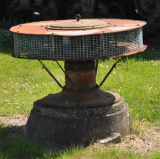
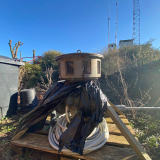
E37D
The E37D is another omnidirectional siren produced by DISA, being relatively similar to the E37, with the exception of a large mesh screen surrounding the siren's stator. Aside from this, the siren is relatively identical to the E37. The siren is able to be heard from up to 0.8 kilometers (0.4 miles) and weighs 140 kilos. Similarly, around 500 units were produced.[1] It can be assumed they were discontinued when World War II ended in 1945. Several units still exist today, with one being located at the Zeppelin Museum in Denmark.
LS 8
The LS 8 is another siren produced by DISA. Due to a lack of information, little to nothing is known about this siren. Little to none of these are known to exist. The LS 8 was mentioned in a manual for the BD 8[2], but aside from this, nothing else is known about them. It can be assumed they were discontinued when World War II ended in 1945.
LS 8D
The LS 8D is presumably a variant of the LS 8. Like its counterpart, little to nothing is known about it. Only 71 LS 8Ds were made.[3] It can be assumed they were discontinued when World War II ended in 1945.
Gas Powered Sirens
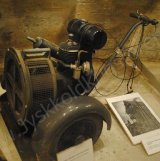
BD 8
The BD 8 is a gas-powered mobile siren produced by DISA and is arguably their most well-known. The main purpose of the BD 8 was to alert the Danish population in the event that stationary sirens were not able to function for whatever reason. Interestingly, mobile gas-powered sirens like the BD 8 had to be transported on the bed of a pick-up truck or small cargo truck, as it was illegal to transport them via moped or motorcycle.[1] The BD 8 makes use of a single-cylinder two-stroke type MK.25C Villiers petrol engine directly coupled to the rotor. It has an 8 port chopper and stator that can have the pitch and sounds output controlled by the throttle as well as a manually controlled shutter to close off the ports. A "special ignition key" is required to start the motor.
A pulley for starting the engine is attached to the crankshaft, provided with a notch for a pawl, so that the piston, when the engine is not in operation, can be moved to cover the siren's ports with a code ring, located around the siren's stator. The siren's fuel tank can hold a volume of 2.51 liters. The entire unit is attached to a two-wheeled cart which allows the siren to be transported to multiple locations. It can be assumed they were discontinued when World War II ended in 1945. Today, a handful of units exist, with a few going to museums and at least 2 being privately owned.
Hand Operated Sirens
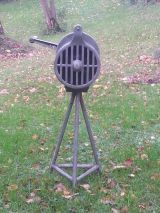
Hand operated siren
One particular model of hand operated siren is known to have been produced by DISA during the time they manufactured air raid sirens during World War II. Due to a lack of information regarding this siren, its model name is unknown. The siren utilizes a small, what looks to be 6 or 8 port rotor, which is driven by a hand crank with a wooden handle at the back of the siren. On the top of the stator, there is a small handle that allows for the siren to be carried. The siren is held up by a small 3-legged metal stand. There is a mesh screen surrounding the ports of the stator, as the siren is small enough to be handheld and could potentially cause injury if misused. There is also a grille on the front of the stator because of this.
Below the base of the hand crank on the back of the siren, there is a small DISA logo and a tag that reads "Dansk Industri Syndikat", as well as smaller text below reading "Taastrup". These hand crank sirens were produced from 1935 to 1942. 500 of them were made, but only 1 is known to exist as of today.
